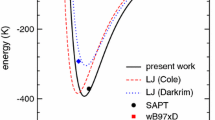Abstract
A model to facilitate the computation of the most stable conformer of associated M · H2O (M being a polar molecule) which depends upon the electrostatic interaction energy between the two associated molecules is proposed and tested. SCF electrostatic potentials for the M molecule and a suitable point charge distribution for H2O were employed in the model computations. Energies predicted by the model are found to be in good agreement with those resulting from an ab initio minimal STO basis SCF treatment of some conformations of the H2O dimer.
Zusammenfassung
Ein Modell zur Durchführung der Berechnung des stabilsten Konformeren eines Assoziationskomplexes M · H2O, wobei M ein polares Molekül ist, wird vorgeschlagen und untersucht. Es basiert auf der elektrostatischen Wechselwirkung zwischen beiden Partnern, und zwar wird für das Molekül M der elektrostatische Anteil seines SCF-Potentials und für H2O eine angemessene Punktladungsverteilung zugrunde gelegt. Die resultierenden Energien sind in guter Übereinstimmung mit denen, die sich bei einer ab initio Rechnung mit minimaler STO Basis ergeben.
Similar content being viewed by others
References
Bernal, J. D., Fowler, R. H.: J. chem. Physics 1, 515 (1933).
Magat, M.: Ann. phys. 6, 108 (1936).
Verwey, E. J. W.: Recl. Trav. Chim. Pays Bas, Belg. 60, 887 (1941).
Rowlinson, J. S.: Trans. Faraday Soc. 47, 120 (1951).
Bjerrum, N., Danske, K.: Vidensk. Selsk. Skr. 27, 1 (1951).
Pople, J. A.: Proc. Roy. Soc. (London) A 205, 163 (1951).
Campbell, E. S.: J. chem. Physics 20, 1411 (1952).
Cohen, N. V., Cotti, M., Iribarne, J. W., Weissmann, W.: Trans. Faraday Soc. 58, 490 (1962).
Coulson, C. A.: Hydrogen bonding, ed. by D. Madži, p. 339. London: Pergamon Press 1959.
Aung, S., Pitzer, R. M., Chang, S. I.: J. chem. Physics 49, 2071 (1968).
Morokuma, K., Pedersen, L.: J. chem. Physics 48, 3275 (1968).
Kollman, P. A., Allen, L. C.: J. chem. Physics 51, 3286 (1969).
Diercksen, G. H. F.: Chem Physics Letters 4, 373 (1969).
Del Bene, J., Pople, J. A.: Chem. Physics Letters 4, 426 (1969); J. chem. Physics 52, 4868 (1970).
Hankins, D., Moskowitz, J. W. Stillinger, F. H.: Chem. Physics Letters 4, 527 (1970).
Morokuma, K., Winick, J. R.: J. chem. Physics 52, 1301 (1970).
Bonaccorsi, R., Scrocco, E., Tomasi, J.: J. chem. Physics 52, 5070 (1970).
Schneider, W. G.: J. chem. Physics 23, 26 (1955).
Author information
Authors and Affiliations
Additional information
Work performed with the financial support of the Consiglio Nazionale delle Ricerche, through its Laboratorio di Chimica Quantistica ed Energetica Molecolare.
Rights and permissions
About this article
Cite this article
Bonaccorsi, R., Petrongolo, C., Scrocco, E. et al. Theoretical investigations on the solvation process. Theoret. Chim. Acta 20, 331–342 (1971). https://doi.org/10.1007/BF00527188
Received:
Issue Date:
DOI: https://doi.org/10.1007/BF00527188




